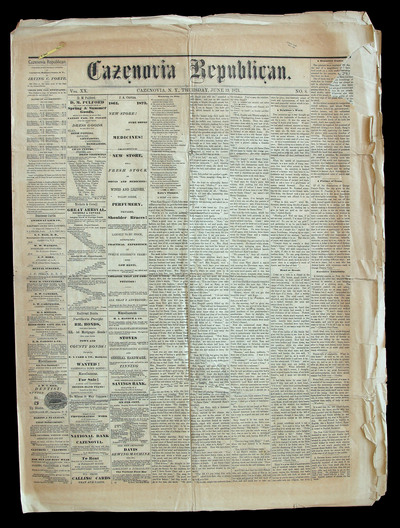The history of the printing press is a somewhat muddied one. With inventors working across multiple countries and continents, only a loose trail of patents, and a lack of clarity regarding the provenance of certain improvements, a complete and accurate timeline is nearly impossible. It is clear, however, that there were several major inventions during the 19th century that revolutionized the printing industry and made the mass publishing a reality.
Between 1450 and the early 19th century the printing press remained almost unchanged. The traditional screw press, though functional, was slow because it required the printing matrix to be cranked up and down for each pressing. In 1802, a German printer named Friedrich Koenig set out to create a faster printing method by using a cylinder press which featured plates of typeface fixed to a cylinder.1 As the cylinder rotated, the plates would come into contact with the substrate. By drawing the paper through the press in time with the rotation of the cylinder, impressions could be made at a near-continuous rate. Unfortunately, the operating speed of the press was limited by the phyiscal strength of its human operator. Here, Koenig saw potential for additional improvement. Rather than relying on a pressman to power the cylinder, Koenig’s press made use of the steam engine. This allowed the press to function with increased speed and made it nearly autonomous, further reducing the cost of printing. By 1814, Koenig's press was being used to produce the widely circulated London Times, making 1,100, impressions per hour and by 1818, after additional refinements, had reached an astounding 2,400 impressions per hour.
Koenig’s printing press remained the predominant printing method until the middle of the 19th century when an American, Richard M. Hoe, revolutionized the cylinder press. Rather than using flat plates, Hoe curved his text plates around a cylinder, allowing the drum to spin at a constant speed, making a greater number of impressions per hour.2 He further improved the press by adding an inking roller which would come in contact with the type during its rotation, eliminating the need to stop the press for re-inking. The first model of the press, dubbed “Hoe’s Cylindrical-Bed Press” was completed in 1846 and was capable of producing more than 100,000 impressions per day.3 The steam-powered rotary press was further improved upon with the addition of both a second cylinder which allowed for simultaneous double-sided printing, and a roll of paper known as a web that was continuously fed into the press.
A printing process known as lithography was first developed in the last decade of the 18th century. Lithography was a process that used hydrophilic and hydrophobic chemicals to produce a desired pattern in ink on a smooth plate. The ink was then transferred to a rubber roller which, in turn, was rolled across a length of paper, producing the final product. The process was relatively fast and inexpensive, but was difficult to use and often resulted in poorly printed images. As a result, most commercial printers until the late 20th century preferred to use physical type rather than lithography. Since the 1970s, however, lithography has been greatly improved by digital, photographic, and computer-controlled processes, and is the predominate process used in large-scale printing today.
While Koenig and Hoe, among others, had succeeded in increasing the speed of the printing press, they had not solved the problem of typesetting, a slow and therefore costly process. Various inventors and engineers began exploring ways to improve the typesetting process and, in 1884, Ottmar Mergenthaler produced the first linotype machine. The linotype machine allowed an operator to mechanically assemble a line of single-letter/symbol matrices in any order he or she chose, using a keyboard-like input device. Once the line was assembled, the matrices were automatically filled with molten metal and then cooled. This resulted is a single line, or slug, of cast type which could then be fitted on a press with other slugs cast by the same process. This process eliminated the need for printers to set type by hand and therefore greatly reduced the time and number of workers required to create a page of type. As a result, text could be produced in greater volumes at a much cheaper rate. Linotype technology was first used in the summer of 1886 for the printing of the daily newspaper the New York Tribune where it proved to be a great success. Empowered by this new printing technique, newspapers were able to expand their content offering and decrease costs, thereby reaching a larger market.
Notes
- “Printing Machine,” The Century Dictionary and Cyclopedia (New York, NY: The Century Company, 1911). Return to text ↑
- Hoe, Richard M. U.S. Patent #5199 (New York: United States Patent Office, July 24, 1847). Return to text ↑
- Ekilson, Stephen. Graphic Design: A New History (New Haven: Yale University Press, 2007), 24. Return to text ↑

